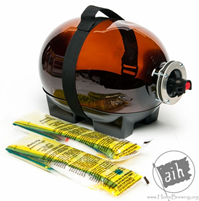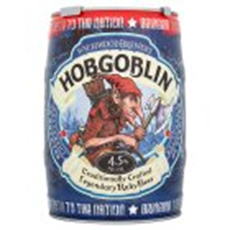Research
So begins the search for alternative options for storing and serving my homebrew. There are some options I already had in mind, but I wanted to do a little research anyway.
…
Have you got the bottle?
The first idea that sprung to mind was to simply use larger bottles. Wine has been served from Flagons for thousands of years, and for hundreds Cider and Mead has been served from Flagons with sturdy corks. Modern versions exist in many forms too. There are traditional style cider flagons with pressure corks and caps, PVC versions with screw tops, and stainless steel growlers. All come in a variety of sizes at a variety of prices.



The traditional shape PVC Flagons are affordable, and are generally around 2.5L and 5L. Sounds great – but they can be heavy and awkward to pour from when full, and their shape isn’t the most convenient for space saving storage even when empty. The stainless steel growlers are smaller (often small enough to fit in a fridge door) and slightly easier to store, but at a significant price hit. Both solutions are great for storing and carbonating just like a standard 500ml bottle, but realistically should only be opened if you know that all the beer will get drunk. Leftovers go flat and off pretty quickly. Also, these things aren’t easy to clean (although you can negate that by caring for them properly and cleaning immediately after use).
…
Oink oink
Another option I’ve been recommended to use in the past are alternatives similar to my 5L plastic kegs such as the beer box and, my personal favourite, the Party Pig. The two big advantages of the part pig are 1) the tap is MUCH cheaper, and 2) it uses an inflatable bag inserted into the keg which you inflate with air to keep the pressure up – no CO2 cost at all!


However unfortunately while the taps are cheaper (less than a tenner), meaning I could have more beers on tap at once, the bottles themselves seem unproportionally expensive (over £25) which means the overall cost isn’t that great. Also… small point… I can’t find anywhere to buy from in England, and the shipping cost is astronomical so… back to the drawing board!
…
Easy Peasy
5L mini kegs (sometimes also called Easy Kegs) are an option I have considered many times. There are a few varieties available too. The main two versions are essentially with built in tap, or without. The most commonly available type is the version without the built in tap, which uses a top-tap system with a 8g CO2 build injector to pour the perfect pint just like from a larger commercial keg. The less common, but still readily available, version with the built in tap simply relies on a bung which has a valve on the top. Open the valve, pour your beer, simple as that.
These things are light weight, small enough to fit in fridges (sometimes admittedly with some rejigging of the shelves), a decent size for sharing, stack on top of one another when full and empty. They’re not super easy to clean, but again you can negate that by caring for them properly and cleaning immediately after use… seems like I’ve found a winner!!! Oh… but wait…


Sadly there are downsides, and they’re pretty significant. The version without the built in tap has pretty much the same problem my plastic 5L kegs have – the kegs are cheap but the tap costs upwards of £40, so if I want to serve 3 beers simultaneously I will have to spend over £120 just on taps… The versions with the built in tap are much more affordable though right?! Less than £10 for a ready to go keg including tap and a way to let the beer flow since it’s gravity fed… however if any of you have tried those kegs from the supermarkets you will know, first of all the beer in the keg goes flat FAST. By the 3rd or 4th pint if you’re lucky . And on top of that, letting oxygen flow into your keg is not the best way to preserve your beer. Almost all the commercial ones warn that you should drink the beer within 2 days or risk drinking really rank beer. Fine for parties, not great for leftovers or drinking on my own.
…
I know my jokes are Corny
So at this point it looks like my reservations about cost might have to be put to one side. If large amounts of money are necessary anyway, lets consider a slightly more expensive option…
Corny kegs were originally used in pubs to serve soft drinks, but have been rapidly adopted by the homebrew scene. They some in two commonly available sizes (19L and 10.5L) which are pretty much perfect for standard whole or half homebrew batches, they are a completely closed system using CO2 to keep the keg under pressure and the drink protected from spoiling, they can be daisy-chained together for both larger batches and for filling smaller kegs from larger ones for taking to parties, the benefits go on and on.



The two most significant down sides to Corny Kegs (and all similar growler and keg solutions) are Cost, and size. Essentially, the large kegs themselves are pretty expensive, anywhere from £50 to £100+ depending on condition, and a 19L (plus CO2, taps, and so on) isn’t easy to lug around to parties. So get a smaller keg… well, the kicker is that since most of the cost is related to the mechanics at the top of the keg (the CO2 and fluid out fittings, pressure rated lid, etc) the cost difference between the smallest available keg and the largest just isn’t that much. Even a small 5L keg costs £50+
On top of the keg cost, CO2 is an important factor. Most choose to gas their kegs with an s30 cannister, which is a larger 240g gas canister, which is more portable but adds weight and makes taking it to parties more cumbersome. Other options are to use a full “pub size” CO2 tank, which is more for the “serve from home” setup, or get an 8g/16g attachment for the gas in valve, but since you are pumping the beer up and out , defying gravity the entire time you serve, most people report they need quite a lot of CO2 bulbs to serve all of their beer.
As a long term homebrew setup solution, Corny Kegs are the way to go, and one day I will definitely invest in some and attach wall taps to my brewing shed. But right now it’s just not a viable option from cost alone, never mind considering factors of transportability and convenience.
…
Booze and Bicycles
Honestly the more research I did the more disillusioned I became. I simply didn’t have the money for the best setups, and the cheaper setups had drawbacks that simply outweighed any issues with my existing equipment.
I had almost given up on this whole idea, and was reserving myself to simply living what I had. My wife told me to treat myself to some booze to cheer myself up and while wandering around the supermarket I found a keg of Hobgoblin on offer… “Wow that’s almost as cheap as my homebrew! It’s a shame the mini keg with a tap is just gravity fed like these things, they would be perfect if there was some cheap and easy way to inject CO2 instead. Oh that reminds me, I need a new CO2 injector for my bicycle…”


Now there’s a thought…


















